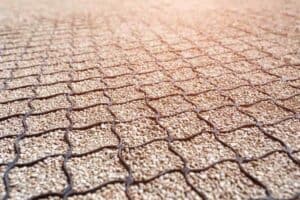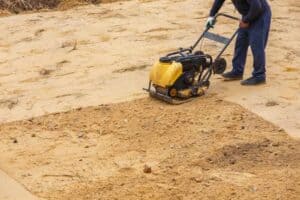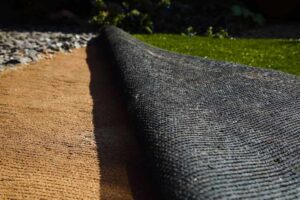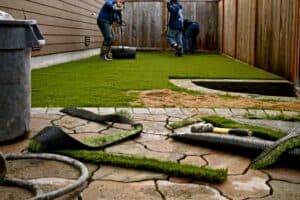5 min read
Last updated: September 4, 2023
When installing artificial grass, one of the most important steps is properly preparing the base that goes beneath the synthetic turf. A proper base ensures the fake grass will be stable, drain well, and look great for years to come.
Here are the main options for base materials under artificial grass:
Crushed Stone/Gravel Base
A crushed stone or gravel base is the most common and recommended base for artificial turf. The crushed stone should be 3/4 inch or smaller gravel rocks. A layer 1-2 inches deep provides the ideal amount of stability and drainage. The rock base allows water to easily drain through the artificial grass carpet and prevents pooling or puddling on the surface. The gravel also provides a firm, smooth foundation for the fake grass to lay on top of.

Paver Base
Paver base is very similar to gravel but is composed of smaller stones mixed with sand. This creates a compactable, stable surface that can be installed 2-3 inches deep under artificial grass. Paver base may provide even better drainage than plain crushed stone. The sand allows water to percolate down through the base. Paver bases are commonly used under patios and walkways.
Compacted Soil
In some cases, the existing soil or substrate can be used under artificial grass if it is properly compacted. This is the most affordable option, but soil may not provide the same stability and drainage as gravel or paver bases. The key is compressing the soil to create a firm, flat surface. A rented gas-powered compactor can help achieve the right level of soil compression.

Sand
Sand is another viable base material under fake grass. Sharp, coarse builders sand approximately 1-2 inches deep works best. The sand easily allows excess moisture to drain straight down through the artificial grass carpet. The biggest downside to sand is that it can erode or shift over time if not contained properly.

Padding
For playgrounds, recreational areas, or pet applications, a base layer of cushioning padding is sometimes installed. Recycled rubber mulch pads or specialty turf padding can provide extra fall protection and comfort. The padding is installed over the crushed rock or gravel base.
Check out our 10mm Shockpad Underlay
Optional Layers
Weed Membrane
An essential layer for any homeowner who dreads weeds poking through their pristine lawn. This thin, permeable fabric prevents weeds from growing upwards while still allowing water to percolate down into the subsoil.
Check out our Weed Control Fabric Membrane
Infill
Once the artificial grass is laid out, infill material, often sand or rubber crumbs, is spread and brushed into the turf. This gives the grass blades support, adds weight to keep the turf in place, and ensures the pile remains upright for a natural look.
Preparing the Base for Artificial Grass Installation:
Assessment and Planning:
- Measure the area to determine the amount of material needed.
- Check for drainage patterns and ensure the surface will allow water to drain away.
- Decide on the depth of excavation, typically 3 to 4 inches for general landscaping.
Clearing and Excavation:
- Remove any existing grass, plants, or debris from the area.
- Dig out the area to your desired depth, ensuring a uniform level.
- If there are tree roots or stones, remove them to avoid any unevenness.
Compaction and Leveling:
- Use a mechanical compactor or a hand tamper to compact the soil, ensuring a solid base.
- Make sure the surface is level; any slight slope should be directed away from buildings for proper drainage.
Install a Weed Barrier:
- Lay down a weed membrane or barrier to prevent weeds from growing through the artificial grass.
- Secure it with landscape staples or fixing pins to ensure it stays in place.
Sub-base Material:
- Use a coarse, crushed stone or recycled concrete for the sub-base.
- Spread the material evenly across the excavated area.
- Compact the material using a compactor until it’s solid and smooth.
- Ensure the sub-base has a slight gradient for effective water drainage.
Final Leveling:
- Use a fine layer of leveling sand on top of the compacted sub-base to smooth out any minor imperfections.
- Compact this layer too, so it’s firm and even.
Moistening and Compacting:
- Lightly moisten the area using a hose.
- Compact the area again to ensure maximum density and a solid foundation.
Edge Restraints:
- Install rubber edging strips restraints around the perimeter if desired. This helps to keep the base material and artificial turf in place.

Bottom Line
The bottom line is that a stable, drainable base is crucial for artificial grass performance. Following the manufacturer’s base preparation guidelines is recommended.
While crushed stone and paver bases are most common, sand, soil, and padding are other options under synthetic turf. Proper base installation allows the artificial grass to last for many years.
If you have any additional questions, please contact our friendly team. Alternatively, you may want to consult our in-depth guide on How to Lay Artificial Grass | Step-by-Step DIY Guide
Related Category: Artificial Grass FAQ
